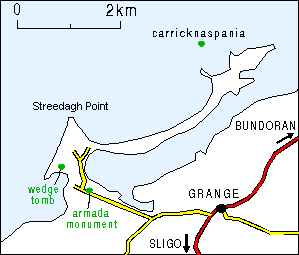Sensational Find at Streedagh
Armada Artefacts Should Remain in Sligo, Expert
A special museum in Sligo to house the Spanish Armada artefacts is being
mooted following the sensational discovery in fifteen feet of water of a vessel from the
fleet at Streedagh off the North Sligo coast where three ships are believed to have been
wrecked in 1588. The find, being hailed by experts as one of the most important
archaeological discoveries of the century, was made by a team of British and Scottish
divers. One of the leading maritime experts in Ireland, Mr Kevin Crothers, who took part
in the dive, said yesterday that the artefacts taken from the wreckage should be housed in
Sligo.
Further exploration of the wreck, and the subsequent housing of items salvaged from it,
will be greatly influenced by the availability of Government finance for the project. It
is believed that representations have already been made to Sligo Minister of State for the
Arts and Culture, Ted Nealon, whose brief also covers museums, to ensure that the majority
of the artefacts will remain in Sligo. Archaeological sources say such a museum would
become a major international tourist attraction.
The vessel, believed to be the Juliana, was found last week by a team of divers
working under the direction of Doctor Colin Martin of Edinburgh, who has led previous
diving explorations of Armada shipwrecks. Aided by new developments in underwater
technology, the wreckage was located buried in sand at Streedagh where, it is thought,
three Armada vessels foundered in 1588 after the Spanish fleet abandoned an ill-fated plan
to invade England.
 Three
bronze cannons and a cannon ball recovered from the wreck are being housed by the Board of
Public Works in Dromahair.
Three
bronze cannons and a cannon ball recovered from the wreck are being housed by the Board of
Public Works in Dromahair.
The items, in excellent condition, consist of a ship’s gun weighing one and a half
tons and over seven feet in length; two smaller stone firing guns which were earmarked for
use on land and a cannon ball.
BACK


 Three
bronze cannons and a cannon ball recovered from the wreck are being housed by the Board of
Public Works in Dromahair.
Three
bronze cannons and a cannon ball recovered from the wreck are being housed by the Board of
Public Works in Dromahair.